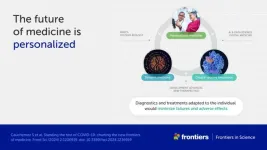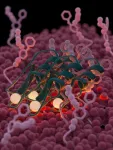Features of bloodstream infection among immunocompromised oncology patients presenting to the emergency department with fever
2024-05-23
(Press-News.org) Background and Aims
Oncology patients undergoing cancer treatment and experiencing episodes of fever are known to be at increased risk for invasive bacterial infection, including bloodstream infection. This study aimed to identify the incidence of bacteremia along with the bloodstream isolates for immunocompromised oncology patients referred to the emergency department (ED) due to fever.
Methods
Oncology patients with fever were referred to the ED according to a protocol previously reported. Virtually all children had central venous access devices (CVAD) that underwent sterile access according to Hematology-Oncology (Hem-Onc) and ED protocol. Antibiotics were administered to all patients once CVAD were accessed and laboratory studies, including blood culture, were obtained. Data collected included patient demographic features, complete blood count profiles, proportions receiving antibiotics within 60 minutes of ED arrival and subsequent blood culture results.
Results
Of 1,088 consecutively referred Hem-Onc patients, 439 were eligible for inclusion. The overall blood culture positive rate was 5.7%. Fifty-six percent of patients with positive blood cultures had an absolute neutrophil count greater than 500 µL at the time of ED presentation. Gram-positive organisms comprised 64% of isolates while gram-negative organisms accounted for 36% of the total isolates.
Conclusions
Immunocompromised oncology patients presenting to the ED with fever are susceptible to bloodstream infection caused by an array of gram-positive and gram-negative organisms. Bloodstream infection during episodes of fever includes many patients without severe neutropenia at presentation and with bloodstream isolates not typically associated with catheter-related bloodstream infection alone, highlighting the diversity and variability within this patient population.
Full text
https://www.xiahepublishing.com/2996-3427/OnA-2023-00047
The study was recently published in the Oncology Advances.
Oncology Advances is dedicated to improving the diagnosis and treatment of human malignancies, advancing the understanding of molecular mechanisms underlying oncogenesis, and promoting translation from bench to bedside of oncological sciences. The aim of Oncology Advances is to publish peer-reviewed, high-quality articles in all aspects of translational and clinical studies on human cancers, as well as cutting-edge preclinical and clinical research of novel cancer therapies.
Follow us on X: @xiahepublishing
Follow us on LinkedIn: Xia & He Publishing Inc.
END
ELSE PRESS RELEASES FROM THIS DATE:
2024-05-23
COLUMBUS, Ohio – Economic difficulty caused by the COVID-19 pandemic led to a cascade of connected problems for some parents – resulting in mental health problems for their children, a new study suggests.
Researchers found that economic insecurity was linked to higher levels of depressive symptoms for parents, which was then associated with poorer relationship quality for the couples. That was linked with more harsh parenting and then to increased internalizing behaviors for their children.
“Pandemic-induced ...
2024-05-23
Summer is coming and that means more boats in the sea. Danish coastal waters are especially cluttered with small boats in the summertime. Locals water skiing, going fishing or just riding around the beautiful bays and fjords.
In general people relax and have a good time on the water, but that is unfortunately not the case for the harbor porpoise.
The more motor boats speeding noisily around, the more they are disturbed. And that can be a big problem for the animals.
Because the harbor porpoise is a relatively large animal that feeds on small fish it needs to spend a lot of time hunting. New research shows that it spends around 60 percent of its time on the hunt, but ...
2024-05-23
In organic chemistry, π-stacking systems are supramolecular structures that arise due to the dispersion force, a type of intermolecular noncovalent interaction. They are a common occurrence in nature; the stabilized structure of DNA is a very prominent example of a π-stacking system, and so are the arrangement of amino acids in certain proteins. Interestingly, π-stacking can be leveraged in the design of materials with useful electronic and optical properties. These include organic semiconductors of various kinds, as well as conjugated polymers for sensing and biomedical applications.
Thus far, a good portion of technologically relevant π-stacking system has been limited ...
2024-05-23
The first scientific pictures from the Euclid satellite mission have revealed more than 1,500 billion orphan stars scattered throughout the Perseus cluster of galaxies.
Led by astronomers from the University of Nottingham, this discovery sheds light on the origins of these celestial wanderers.
The Perseus cluster, located 240 million light-years away from Earth, is one of the Universe's most massive structures, boasting thousands of galaxies. However, amidst this cosmic ensemble, the Euclid satellite captured faint ghostly light - the orphan stars - drifting between the cluster's galaxies.
Stars naturally form within galaxies, so the presence of orphan ...
2024-05-23
As the European Space Agency publishes the first findings from its Euclid space telescope, scientists from the University of Surrey are celebrating fresh insights from the data.
Dr Denis Erkal, Associate Professor of Astrophysics at the University of Surrey, studies how the gravity of the Milky Way pulls clusters of stars apart, creating streams of stars trailing across the galaxy.
Now, his model for how this happens (video HERE) has been confirmed by data from Euclid.
Dr Erkal said:
“For a long time, my modelling ...
2024-05-23
Scientists have released the first set of scientific data captured with the Euclid telescope, showing an exciting glimpse of the Universe’s distant past.
The telescope, launched in July 2023, is part of the Dark Energy Satellite Mission, which aims to map the dark Universe.
Led by the European Space Agency in collaboration with The Euclid Consortium - which includes astronomers at The University of Manchester in leadership positions – the mission seeks to unlock mysteries of dark matter and dark energy and reveal how and why the Universe looks as it does today.
Early observations, described in a series ...
2024-05-23
What should the medicine of the future look like? A team of scientists writing in Frontiers in Science lays out a bold vision for precision approaches to understanding, preventing, and treating diseases, driven by revolutionary technologies and new interdisciplinary collaborations between researchers and other health sector professionals. The internationally renowned authors – led by Prof Michel Goldman, recipient of the Blaise Pascal Medal 2024 for his exceptional contributions to immunology and healthcare innovation, and leading microbiologist Prof Philippe Sansonetti from the Institut Pasteur and Collège ...
2024-05-23
Peer-reviewed - survey - people
Nurses who assess patients at emergency departments would like more training and say their decisions can be negatively impacted by the high pressures of their work.
Researchers at the University of East Anglia conducted the first ever UK survey of triage nurses to discover the background, training and decision-making processes of this role in emergency departments.
Lead author Hugh Gorick, a PhD researcher at UEA’s School of Health Sciences who also works as an assistant practitioner in an NHS hospital’s Acute Medical Unit, said: “More than 24 million patients present to emergency departments ...
2024-05-23
Water scarcity will intensify with climate and socioeconomic change, disproportionately impacting populations located in the Global South. So concludes a new Utrecht University article published in Nature Climate Change on 23 May 2024, which used a state-of-the-art global water quantity and quality model to estimate clean water scarcity until the end of the century.
Humans require clean water for drinking and sanitation purposes, but also for the production of food, energy and manufactured goods. As communities and policymakers grapple with water scarcity issues on the ground, researchers ...
2024-05-23
A small antibiotic called plectasin uses an innovative mechanism to kill bacteria. By assembling into large structures, plectasin latches onto its target on the bacterial cell surface comparable to how both sides of Velcro form a bond. A research team, led by structural biologist Markus Weingarth and biochemist Eefjan Breukink at Utrecht University, mapped how the Velcro-structure is formed. Their discovery, published in the scientific journal Nature Microbiology, unveils a new approach that could have broad implications for the development of antibiotics to ...
LAST 30 PRESS RELEASES:
[Press-News.org] Features of bloodstream infection among immunocompromised oncology patients presenting to the emergency department with fever





